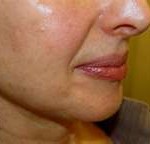
Because the face falls against a more fixed or stable mouth area, a ‘fold’ develops at the junction of the two. Known as the nasolabial fold, melolabial crease, or facial parentheses, this area is a classic sign of aging that does bother a lot of people. The deepening of the nasolabial is one of the most common areas for injectable fillers. In my Indianapolis plastic surgery practice, it is injected more than that of the lips.
But there are other treatment options than injectable fillers to help soften the aging nasolabial folds. A different type of injectable filler is your own fat. Liposuctioning some fat, purifying it, and then injecting into the nasolabial folds is a natural injectable filler. But particulated fat can be unpredictable and its survival is not assured. For this reason, most plastic surgeons will overfill the injection site in anticipation of some resorption afterwards. This is a very logical approach if you are in the operating room anyway and are already having some liposuction done.
Another more effective fat approach, in my experience, is the dermal-fat or fat strip graft. By taking a strip of skin and fat from somewhere else in the body (the outer layer of skin, epithelium, is removed first), the strip graft is thread into the nasolabial folds through a small nick incision at the top and bottom of the fold. This acts like placing an implant although it is not synthetic. It is well known that dermal-fat grafts typically have better survival rates than free injected fat as the attached dermis provides a conduit for early capillary ingrowth. Establishing an early blood supply is the key for optimizing fat graft take.
To use a strip fat graft, however, requires two things; a harvest site and usually an operating room experience. Strip fat grafts will result in a scar and that is a significant consideration. For this reason, I usually like to take it from where one already has a scar, usually on the abdominal area. Previous tummy tucks, c-sections, or vertical abdominal incisions are ideal. The other uncommon option is from an open hairline browlift where a long strip of upper forehead skin is removed in the lifting process. No matter where it is harvested from, the strip fat graft is not an office procedure.
The deep nasolabial fold can be filled with a variety of materials, both synthetic or natural. Fat can be placed through either injection or as a threaded implant. When a favorable donor site exists as part of an operative procedure, the strip fat is a good option to consider for longer-lasting results.
Dr. Barry Eppley
Indianapolis, Indiana


